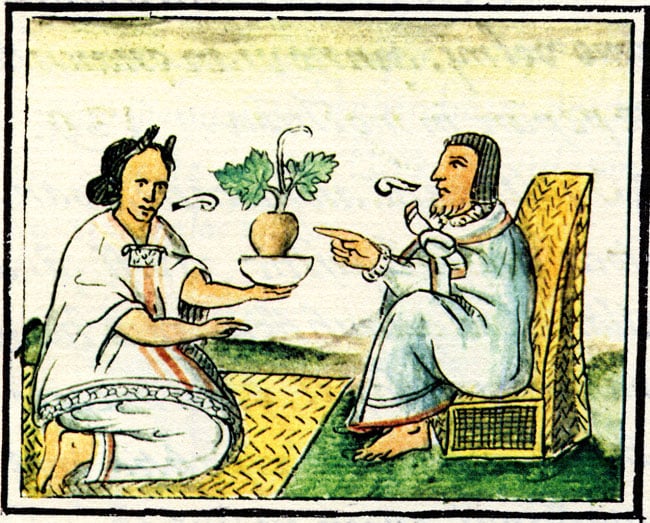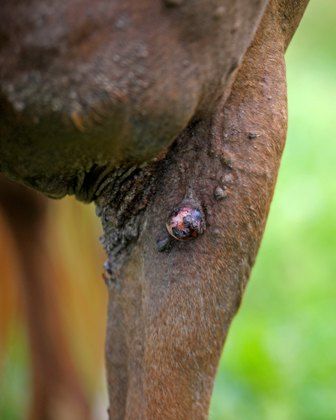 I thought it might be interesting to talk about a particularly annoying type of skin tumor that’s pretty unique to horses. It’s called an equine sarcoid, and it’s unattractive, hard to get rid of sometimes. Fortunately, it’s rarely a serious health problem for horses. But people hate them, so I thought it might be worth bringing them up.
I thought it might be interesting to talk about a particularly annoying type of skin tumor that’s pretty unique to horses. It’s called an equine sarcoid, and it’s unattractive, hard to get rid of sometimes. Fortunately, it’s rarely a serious health problem for horses. But people hate them, so I thought it might be worth bringing them up.
First off, the name. The term sarcoid comes to us from a combination of Greek “sark.” meaning “flesh,” and “-oid,” which is a 19th century medical term roughly meaning “kind of looks like.” So, with a sarcoid, it kind of looks like flesh, at least looking at the origins of the word. To me, they look more like the state of New Mexico when you look down from an airplane at 10,000 feet or more, but, to my knowledge, they don’t have a word for that, so we’ll stick with sarcoid.
In general, horses don’t get a lot of cancers and, when they do, they tend to be benign, that is, they tend not to race through the horse’s body. That said, sarcoids are probably the most common cancer of horses, and are thought to affect something like 2% of the horse population. Even though they aren’t fatal to horses, they can can local tissue destruction and deterioration, sometimes to an alarming extent. In some cases, they can open and get all weepy and make a real mess, too. This, then, can be an open invitation to flies, and, well, you want to take care of them. If they’re in a bad spot – say, the horse’s eyelid – they can interfere with the function of the eye, too. Like I said, you want to take care of them.
 There’s a growing consensus that the tumors are caused by a virus that causes warts in cattle (papillomavirus). Most experts believe that the virus is spread by flies. While experts are pretty confident that horses can develop sarcoids from being around infected cattle, they’re not sure if the tumors can spread between horses. There’s more weird stuff about the virus, too, such as, how it can cause disease in more than one species (most viruses are species-specific) and why it causes tumors in the first place. There’s a lot that we don’t know.
There’s a growing consensus that the tumors are caused by a virus that causes warts in cattle (papillomavirus). Most experts believe that the virus is spread by flies. While experts are pretty confident that horses can develop sarcoids from being around infected cattle, they’re not sure if the tumors can spread between horses. There’s more weird stuff about the virus, too, such as, how it can cause disease in more than one species (most viruses are species-specific) and why it causes tumors in the first place. There’s a lot that we don’t know.
 There’s also a genetic component to sarcoids. For example, in warmbloods, it’s been shown that if you breed two horses with sarcoids, the likelihood that their baby is going to have a sarcoid goes up. On the other hand, some horses, such as Lipizzaners, appear to be somewhat resistant to the darn things. The color of the horse isn’t important (unlike the melanomas that are the bane of grey horses), and the horse’s gender doesn’t matter, either. Sarcoids are an equal opportunity annoyer.
There’s also a genetic component to sarcoids. For example, in warmbloods, it’s been shown that if you breed two horses with sarcoids, the likelihood that their baby is going to have a sarcoid goes up. On the other hand, some horses, such as Lipizzaners, appear to be somewhat resistant to the darn things. The color of the horse isn’t important (unlike the melanomas that are the bane of grey horses), and the horse’s gender doesn’t matter, either. Sarcoids are an equal opportunity annoyer.
The question that interests everyone, of course, is, “What do you do about them?” Here’s where things get interesting.
One of Ramey’s Rules of Medicine is that the less likely any particular treatment is to work for a condition, the more treatments that there are. That’s why for, say, a cut on the horse’s neck, pretty much everyone agrees that you should put the wound edges back together in some way, shape or form. Not really much disagreement. On the other hand, for a condition such as back pain – which really isn’t a condition at all, since pain is a clinical sign of a condition, not a condition in and of itself – you have, oh, dozens of treatments to entertain you (and annoy the heck out of your horse). As an aside, that’s also one big reason why you don’t have any “alternative” ways to put wounds back together – there’s a way, it works, and that’s it. But I digress.
 With sarcoids, there is no surefire treatment that works every time. One treatment is neglect, that is, not to treat them at all. I mean, in most cases, they don’t really hurt horses (unless, as I said previously, you end up with one on your horse’s eyelid or something). Unfortunately, neglect isn’t a very good treatment option because in most cases, the sarcoids tend to keep getting bigger. As a result, even though sarcoids don’t spread through the horse’s system, most people aren’t happy with, say, a grapefruit-sized mass hanging off of their horse somewhere.
With sarcoids, there is no surefire treatment that works every time. One treatment is neglect, that is, not to treat them at all. I mean, in most cases, they don’t really hurt horses (unless, as I said previously, you end up with one on your horse’s eyelid or something). Unfortunately, neglect isn’t a very good treatment option because in most cases, the sarcoids tend to keep getting bigger. As a result, even though sarcoids don’t spread through the horse’s system, most people aren’t happy with, say, a grapefruit-sized mass hanging off of their horse somewhere.
Like most things, early treatment is better and gives you the most chance for success. But which treatment? Here are a few.
1, Surgery. You’d think that you could just cut the things out and be done with them. Unfortunately, even if you cut them out and take some normal tissue, as well (the so called “wide margins” typical of cancer surgery), they often come back (I don’t know any statistics, but I’d say maybe half the time in my experience).
2. Immunotherapy. With immunotherapy, you’re basically trying to get the horse’s body to reject the tumor. One way to do this is to inject bacterial cell fractions into the things. Some people have observed that the simple act of inflammation can set off an inflammatory response that is also inflammatory, so you have people scrubbing them with toothpaste, scraping them, or generally trying to find ways to annoy them and make them go away.
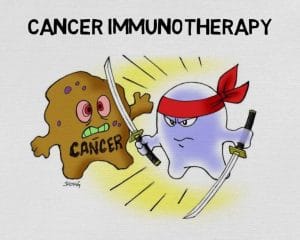 Along those same lines, imiquod (Aldara®) is a drug that works by stimulating the horse’s body’s immune responses. This ultimately causes inflammatory cells to get into the tissue and causes cells to die. Unfortunately, imiquod can cause a pretty nasty tissue reaction in some horses: swelling, soreness, redness, skin irritation, etc. If you get that kind of a reaction going around, say, the horse’s ear, you can end up with a horse that’s head shy, so be careful.
Along those same lines, imiquod (Aldara®) is a drug that works by stimulating the horse’s body’s immune responses. This ultimately causes inflammatory cells to get into the tissue and causes cells to die. Unfortunately, imiquod can cause a pretty nasty tissue reaction in some horses: swelling, soreness, redness, skin irritation, etc. If you get that kind of a reaction going around, say, the horse’s ear, you can end up with a horse that’s head shy, so be careful.
A few years back, a paper was presented whereby the presenters took pieces of the horse’s own sarcoid tumors, froze them, and implanted them back under the horse’s skin. This was a sort of a vaccination against sarcoids (in a way) and the investigators reported promising results. When I’ve been in discussions about this therapy, results seem to be pretty mixed, however.
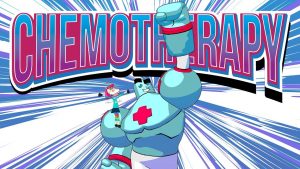 3. Chemotherapy. There are several chemotherapeutic agents that people have used to try to get rid of sarcoids, such as cisplatin or 5-fluoruracil. These are usually injected into or rubbed onto the tumors. A newer option is electrochemotherapy, whereby an anti-cancer agent is coaxed into the cancer cell using a series of electrical pulses. The electrical pulses basically open up the cancer cell membranes and allow the medication – which ordinarily couldn’t get into the cell – to pass through the cell membrane. Good results have been reported with this technique, however, it’s relatively expensive and requires multiple episodes of general anesthesia, so it may not be a popular option for many horse owners.
3. Chemotherapy. There are several chemotherapeutic agents that people have used to try to get rid of sarcoids, such as cisplatin or 5-fluoruracil. These are usually injected into or rubbed onto the tumors. A newer option is electrochemotherapy, whereby an anti-cancer agent is coaxed into the cancer cell using a series of electrical pulses. The electrical pulses basically open up the cancer cell membranes and allow the medication – which ordinarily couldn’t get into the cell – to pass through the cell membrane. Good results have been reported with this technique, however, it’s relatively expensive and requires multiple episodes of general anesthesia, so it may not be a popular option for many horse owners.
4. Cyrotherapy. It’s possible to freeze sacroids with liquid nitrogen. Sometimes they come back anyway.
5. Radiation therapy. This uses high energy rays to try to destroy cancer cells. It’s not usually a first option due to expense.
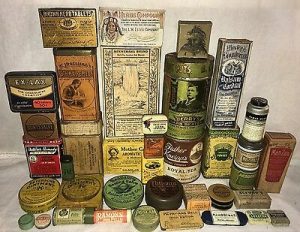 6. “Herbal” cancer salves. This one is a particularly annoying option. It’s not annoying because they can’t do something, rather, it’s annoying because they are usually falsely advertised. Here’s what they have in common.
6. “Herbal” cancer salves. This one is a particularly annoying option. It’s not annoying because they can’t do something, rather, it’s annoying because they are usually falsely advertised. Here’s what they have in common.
- The salves are usually very dark, all the way to black.
- They usually talk about how they have “bloodroot” (sanguinaria) in them,
- They sometimes talk about the zinc chloride in them.
There’s no reason to believe that these “herbal” treatments can’t work and, according to at least one research paper, they “do” work in some cases. However, that reason has absolutely nothing to do with them being “herbal” or “natural” or any other such nonsense. It’s the zinc chloride that’s the thing.
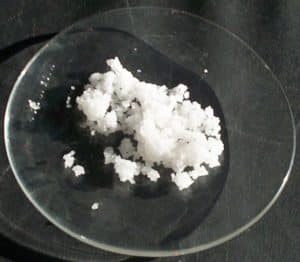 You see, zinc chloride is a caustic chemical that’s been used in the treatment of warts in humans for 100 years or more. It essentially “burns” off the warts. That’s how it works in sarcoids, too. It just burns off the tissue. And rather indiscriminately – it burns off normal tissue, too. That’s why, if you’re going to use it, you should be EXTREMELY careful and especially not use it in areas like the horse’s ear. In the ear, you can burn right through the entire ear, and leave and ugly scar (I’ve seen two).
You see, zinc chloride is a caustic chemical that’s been used in the treatment of warts in humans for 100 years or more. It essentially “burns” off the warts. That’s how it works in sarcoids, too. It just burns off the tissue. And rather indiscriminately – it burns off normal tissue, too. That’s why, if you’re going to use it, you should be EXTREMELY careful and especially not use it in areas like the horse’s ear. In the ear, you can burn right through the entire ear, and leave and ugly scar (I’ve seen two).
This false advertising about these products really bothered me, so I, along with Dr. Robert Poppenga, a toxicologist at the University of California, Davis, studied three of these products. We found that they contained between 11.6% and 25% zinc chloride, which is a lot. The stuff isn’t safe, natural, herbal, or much of anything except indiscriminate in its tissue destruction. It’s such nasty stuff that various international government agencies have warned against the use of these products in human cancer therapy. The study has been published – here’s a link to the abstract.
 So, that’s about it, when it comes to what’s currently known about sarcoids. I hope your horse doesn’t have one. If he does, happily, it’s not going to kill him. But it might be hard to get rid of, so don’t be mad at your veterinarian if the first attempt at treatment doesn’t work. And for goodness sake, if you are going to do something, at least know what you’re using. It’s something of a sarcoid jungle out there.
So, that’s about it, when it comes to what’s currently known about sarcoids. I hope your horse doesn’t have one. If he does, happily, it’s not going to kill him. But it might be hard to get rid of, so don’t be mad at your veterinarian if the first attempt at treatment doesn’t work. And for goodness sake, if you are going to do something, at least know what you’re using. It’s something of a sarcoid jungle out there.







